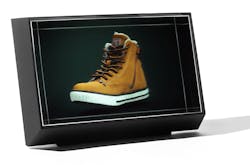Life in 3D: Making the Shift from 2D to 3D Displays
This article is part of TechXchange: Advanced Display Technology.
What you’ll learn:
- The myriad benefits of 3D displays.
- Challenges the industry faces in the move from 2D to 3D display technology.
We’ve all witnessed the hype around 3D display technology over the decades. Some in the industry have tried and failed, mostly due to content not being available, but the hardware wasn't that great either.
While significant progress has been made with the display itself, we’re not quite where we need to be to bring about a massive shift from the 2D to the 3D realm. For example, both the hardware and the software need to be dramatically improved (think, for example, energy consumption, massive computing needs). The entire industry must adopt this transition—from hardware to software to sensor/chipmakers, and everything in between. It’s begun to happen and picking up speed.
But we need more.
For one thing, we need higher-resolution displays—300- to 500-ppi displays, from small to large sizes, to get the best results. We do currently have high-resolution displays, but they tend to be for phones with a notch for the camera or they must be specially made, which renders them unsuitable for the mass market.
For instance, to make really good 3D light field displays, you need such high-resolution displays, which are rare. Even today, it’s hard to get any better than 8K, which is fine for smaller displays. However, for an 85-in. display, it tends to come up short. To clarify, 8K offers plenty of resolution for 2D displays, but not so much for 3D.
Motivation for 3D Displays
The good news, though, is that the metaverse promoters have a huge appetite for 3D displays, and display makers are gearing up to feed the masses. Some will be faster to the market than others. Like with previous new technologies, among the display makers, there will be those who are the innovators and the fast followers, the laggards, and, alas, some will be left behind.
From entertainment to medical, military applications, engineering, graphic design, architecture, and more, 3D display technologies will touch just about every industry, further pushing the boundaries on the human digital experience.
Today, multiple companies are chasing this space, including big players. One is Looking Glass, which has developed the world’s first group-viewable 3D holographic displays. This company, along with other innovators, are designing the highest-resolution and most-realistic experience technically available today.
The entertainment industry is currently the largest draw for 3D displays, followed by enterprise applications like 3D modeling, design, engineering, etc. The next biggest draw will be from brands wanting to showcase their products on a display that best resembles the real thing, which is possible with the 3D light field display (hologram).
A 3D Digital World
In a future 3D digital world, our TVs will resemble the theater; the basketball game on TV will resemble that of courtside seats at the arena; the newest shoe or the piece of jewelry on a 3D display will resemble what you see in the physical store. Flying airplanes during training or performing surgery will be more like the real thing. And our video conferencing will not look like we’re talking to small glowing rectangular boxes; instead, it will resemble an actual conference room (we might even enjoy video calls…ugh).
There will also be less need for designers to mockup cars made of wood or for architects to make a model out of styrofoam because these will look realistic on a 3D display. Rather than going around the model, you can rotate the image of the car or build on your 3D display, and multiple viewers can view and offer input.
There’s evidence that we are on the right track. The pull is coming from a variety of markets. Increased market supply and demand for 3D display technologies could breathe a whole new life into the entire display industry. It will impact all display technologies, from LCD to OLED to emerging varieties like microLED.
Innovation Must Ramp Up
But, like I said, much more innovation needs to happen. Today, everything is 2D and the transformation would mean that the current display hardware must be modified.
The good news is that most of the existing infrastructure in terms of the factories, production lines, materials, and processes for current display technologies can be maintained. In most cases, you can insert additional films and system designs to make them suitable for 3D. Fortunately, these can be done relatively easily and don’t require massive changes.
Some challenges the industry has overcome in the ongoing shift to 3D include:
- Nausea: Since the design was poor, when you moved your head side to side, the image “chopped” and you got a reset of some kind. This issue has been solved by enabling the viewer to see multiple screens at the same time, so there’s no transition.
- Single viewer: Many camera-tracking 3D displays could only enable one person. With a TV or monitor application where you expect multiple viewers, that simply doesn’t work. This challenge has been solved with a multiviewer system where several dozen people could view from a distance.
- Glasses: Most people don't like to wear glasses for extended periods of time unless you’re like me (I’ve been wearing glasses since the fourth grade). All new versions of displays are glasses-free. We will continue to see improvements in this space.
While we still have a ways to go, I do believe significant progress is coming in the display tech space surrounding 3D. Who will fail and who will succeed remains to be seen. Buckle up, it’s going to be an exciting and sometimes bumpy ride. And you can bet, I’ll be wearing my glasses for a clear view of this race.
Read more articles in TechXchange: Advanced Display Technology.
About the Author
Sri Peruvemba
CEO, Marketer International Inc.
Peruvemba, the CEO of Marketer International, has served on the Executive Board and was former Chair of Marketing for many years for the Society for Information Display (SID). With over 30 years of experience in the technology industry, Peruvemba has been an influential advocate in the advancement of electronic hardware technologies. He’s an acknowledged expert on sensors, electronic displays, haptics, touchscreens, electronic materials, and related technologies; and consults, writes, and presents on those subjects globally.


